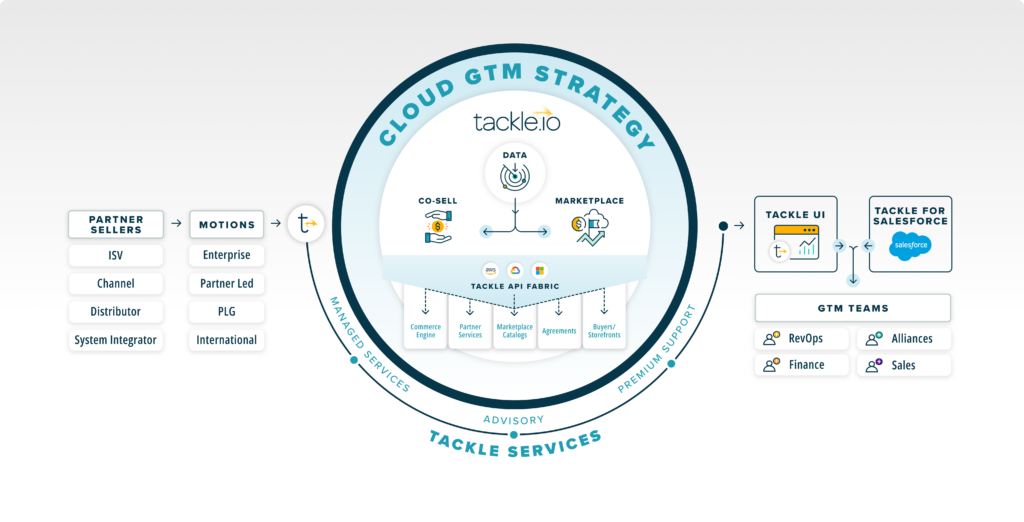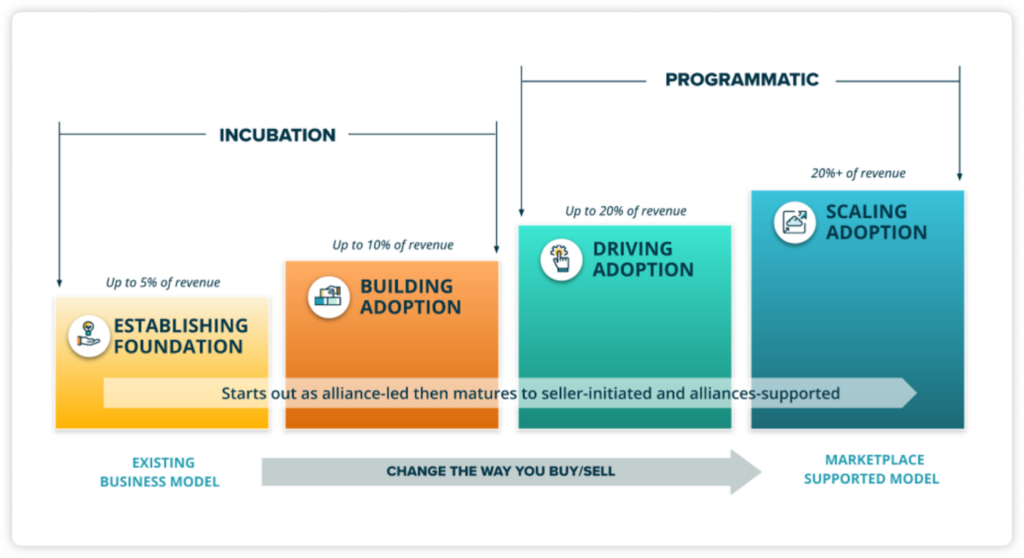We didn’t just write the book on Cloud GTM—we invented the category.
While the market was still figuring out how to get products listed on the marketplaces, Tackle was already building the future of B2B software sales. We coined the term “Cloud GTM” because the old ways of selling software were dying, and someone needed to name what was coming next.
And what came next was a fundamental shift in how software gets bought and sold.
According to our annual State of Cloud GTM Report, Cloud GTM represents 1.5% to 2% of the entire B2B market today. That’s a tidal shift in how deals get done, and a clear sign that the go-to-market strategies of the past simply don’t cut it anymore. The space we created has grown into a thriving ecosystem where multiple players now compete to serve the market we pioneered.
But here’s what makes our approach different: Cloud GTM represents a complete rethinking of how modern software companies grow. In this guide, we’ll break down what Cloud GTM is, why it matters, how to build a winning strategy, and how platforms like Tackle can help you scale it.
What is Cloud GTM?
Cloud GTM is the strategic approach to bringing software products to market through cloud provider ecosystems like AWS, Microsoft, and Google Cloud. But it’s more than just getting listed on a marketplace; it’s about building a repeatable, scalable revenue engine that aligns with how today’s buyers want to buy.
When we talk about Cloud GTM, we’re talking about:
- Pipeline intelligence: Stop guessing which deals could go through the cloud. Use data to identify accounts with committed spend, fast-track procurement needs, or existing cloud relationships and prioritize deals that are most likely to convert via marketplace.
- Strategic co-selling: Turn cloud provider sellers into allies. By aligning on shared customers and value, you unlock earlier deal access, stronger pipeline support, and joint selling motions that expand your reach.
- Marketplace acceleration: Help your reps turn marketplace into a strategic selling advantage. That includes spotting eligible opportunities early, knowing when to bring in a co-sell motion, and using cloud as a velocity lever for bigger, faster deals.
- Operational alignment: Integrate your CRM (like Salesforce) with cloud sales motions to create a single source of truth. Automate co-sell workflows, enrich pipeline visibility, and ensure cloud-influenced revenue doesn’t fall through the cracks.
- GTM transformation: Cloud GTM is a fundamental shift in how you sell. Achieving real impact means treating it like any other revenue-critical motion: with executive sponsorship, clear accountability, and dedicated resources. When embedded into your go-to-market fabric, Cloud GTM becomes a repeatable, scalable engine for growth.
Cloud GTM sits at the intersection of partnerships, products, sales, and operations. Getting it right isn’t just about tools; it’s about transforming how you go to market.
What is a Cloud GTM platform?
A Cloud GTM platform is the operational backbone that makes all of this possible at scale. It’s the technology that connects your internal sales processes with external cloud provider systems, automates the complexity of multi-cloud operations, and gives you visibility to optimize your cloud sales motion.
Think of it as the nervous system for your cloud revenue engine.
Why did we build the first Cloud GTM platform? Because we saw the writing on the wall before the market did. Traditional sales processes weren’t built for the complexity of marketplace transactions, co-sell coordination, and multi-cloud operations. And software sellers shouldn’t have to build software just to sell software. Companies needed purpose-built technology to make cloud selling not just possible, but scalable.
Since then, we’ve helped over 450 software companies launch, scale, and dominate through cloud sales—proving that the category we created isn’t just viable, it’s inevitable.
Benefits of a strong Cloud GTM strategy
So, why go all-in on a Cloud GTM strategy? Here’s what you stand to gain:
- Revenue acceleration: Access pre-committed cloud spend from enterprise buyers, unlock co-sell support from hyperscaler sales teams, and speed up deals by removing procurement roadblocks.
- Operational efficiency: Skip lengthy legal reviews with streamlined procurement, get paid faster and more predictably, and save on channel fees compared to traditional resellers.
- Strategic advantage: Offer private, custom deals that competitors can’t match, build multi-cloud flexibility that enterprise buyers demand, and integrate cloud into your broader revenue strategy for maximum impact. And if you’re product-led? Cloud GTM gives you a frictionless, scalable way to monetize usage and convert free users through a trusted procurement path.
The numbers don’t lie—SaaS spending will grow to $300 billion in 2025, according to Gartner, and cloud marketplaces throughput is projected to hit $50 billion by 2025, based on our own State of Cloud GTM Report. What’s fueling this shift? Cloud marketplaces are growing at a staggering 84% year-over-year, according to Canalsys, outpacing every other cloud channel.
And hey, we get it, GTM talk can get fluffy. But at its heart, it’s about:
- Spreading awareness of your solution.
- Generating and converting leads.
- Expanding into new markets.
- Engaging customers more deeply.
- Outpacing your competition.
Cloud just happens to be the logical channel to do all of that, faster.
How to build a Cloud GTM strategy
Now that you know the benefits of a Cloud GTM strategy, you can understand why a Cloud GTM strategy is your blueprint for winning in the cloud space. It aligns your product, sales, and marketing motions across cloud marketplaces and provider partnerships. Unlike legacy go-to-market models, a cloud-first approach is built for speed, flexibility, and ecosystem collaboration.
Your strategy should account for:
- The cloud providers you’ll partner and build with.
- How you’ll manage listings, co-sell readiness, and CRM integrations.
- What role your direct sales team plays in identifying, driving, and closing marketplace deals.
- The maturity level of your current Cloud GTM motion and your desired future state (something our Cloud GTM Maturity Model can help with).
Since there’s no one-size-fits-all playbook, we’ve curated key focus areas we’ve learned from scaling Cloud GTM across hundreds of companies:
1. Meet your customers where they are
Your buyers don’t care about your internal processes. They care about buying software fast, with minimal friction, using budgets they’ve already committed. If you’re not selling where they want to buy, you’re losing deals to competitors who are.
2. Lead with your technical advantages
If your product runs natively on AWS, integrates with Azure services, or powers Google Cloud AI workloads, you’ve got a competitive moat that’s nearly impossible to replicate. Make it the cornerstone of your positioning.
3. Grow your multi-cloud prowess
Being present in one marketplace is table stakes these days. Being strategic across AWS, Microsoft, and Google Cloud is how you future-proof your business and maximize co-sell opportunities. The broader cloud ecosystem requires strong alliances and solution integrations that will help set your platform and clients up for success.
4. Invest in alliance relationships
The hyperscalers have field sales teams with customer relationships worth millions. Building trust with these teams takes time, but when they start bringing you into their deals, your sales capability multiplies overnight.
How Tackle makes Cloud GTM seamless
Cloud GTM exists because the old way of selling software was fundamentally broken. Long procurement cycles, complex legal reviews, unpredictable payment terms, and limited access to enterprise buyers can’t survive in a world where software moves at cloud speed.
We saw the solution before anyone else saw the problem, and we built the category to meet it. Whether you’re just getting started or ready to scale across clouds, we’ve got the tools, playbooks, and platform to help.
Tackle is purpose-built to help you launch, scale, and win with cloud sales—all without requiring extensive engineering resources. Backed by a team of Cloud GTM experts with years of experience and long-lasting partnerships, we take the complexity out of listings, integrations, and co-sell ops so your team can focus on what matters: growth.
Ready to own your Cloud GTM strategy? Contact us today!




